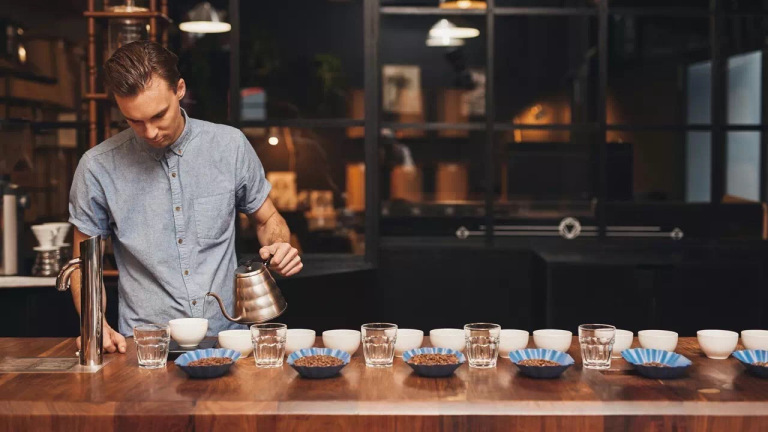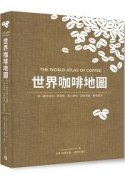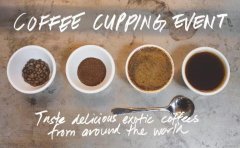A guide to cupping: what is cupping? The purpose and steps of the cup test Standard method of cup test

Professional coffee knowledge exchange more coffee bean information please follow the coffee workshop (Wechat official account cafe_style)
Coe Cup meter evaluation items and record key points as well as evaluation instructions
Today I will tell you what a cup test is, why and how to do it, as well as the commonly used coffee description language and quality evaluation methods. The purpose of the cup test is to enable people who love coffee to better enjoy the taste of coffee and explore the world of coffee more deeply.
For people in the industry, cup testing is undoubtedly a science, which requires long-term training to master it, but in fact, even lovers who have just come into contact with coffee can understand coffee better through cup testing. The cup test method is actually very simple, and the method and conclusion are not right or wrong, everyone may taste different, the purpose of the cup test is to show your real experience of coffee.
? What is a cup test?
A cup test is a method used to identify the characteristics and taste of a particular cup of coffee, which allows us to compare different varieties of coffee so as to better understand the characteristics of each type of coffee.
Since the key to cup testing is comparison, the method of each cup test must be completely unified so as not to affect your perception of the taste of coffee.
? Why the cup test?
The purpose of the cup test is to taste the coffee. Cup testing can help people decide how to mix coffee, or whether coffee should be used to make espresso or hand-brewed coffee. Cup testing can also help people tap the potential of coffee and identify the tiniest taste features. Through the cup test, we can compare the flavor of different plantations, different producing areas, different countries and different batches of coffee, and then better understand the characteristics of each type of coffee.
? How to measure the cup
As I just said, there is no difference between right and wrong. Today, I would like to introduce to you the standard method of textbooks. I personally suggest that beginners should strictly follow the standard method to test the cup, so as to avoid errors in the taste of coffee, making it impossible for you to taste the original flavor of coffee.
1. Cup test procedure
I personally like to use lightly roasted sample coffee during the cup test, which makes the quality or poor taste of the coffee more obvious, and the taste will not be greatly affected by the baking process. For professionals, the ideal cup test should be to roast and grind raw beans with fresh samples, which will give them a better understanding of the grade of coffee, test the dry aroma of coffee, and judge the quality of raw beans.
Of course, for enthusiasts, we only need to buy a favorite, freshly roasted coffee. I suggest you only use the soaking method for brewing. First grind the coffee beans to a rough degree, pour the coffee powder into a small bowl, pour into boiling hot water (95 °) and soak for 3-4 minutes.
I think the most critical moment of cup testing is to "break the shell". This step can fully release the aroma of the coffee. Be sure to calm down and smell the aroma of the coffee after the "broken shell", and then start tasting it. After breaking the shell, you need to gently stir the coffee to let the rest of the coffee grounds sink to the bottom, and the coffee grounds floating on the surface must be skimmed off.
Once the coffee grounds on the surface are all cleaned up, you can start tasting. Don't be afraid that the sound of smoking coffee is not standard, because everyone's voice is different. Personally, I will try to keep my voice down when drinking coffee, but others may tell you that the louder the better. Scoop a spoonful of coffee with a deeper spoon, close to the lips, suck the coffee into the mouth and spray it fully into the mouth. The inhalation will form a stream of coffee "steam", making it easier to detect the various tastes and aromas of the coffee.
The next step is to use words to describe the taste and aroma you perceive. Here I want to tell you: really don't be afraid to make mistakes! I have personally experienced numerous cup tests, and each time I will taste some taste that others do not perceive, and I will not be able to taste the taste described by others, and sometimes the cup test is a dozen cups, our taste buds will also be tired, the sense of taste will become slow, at this time must have a rest, so that your sense of taste is zero. By the way, you'd better not drink coffee. You can't drink so much coffee!
Whether you are a beginner or an expert, you must record your true feelings at any time during the cup test. you can download the standard "coffee flavor wheel" online and compare it with the "flavor wheel" after the cup test. check to see if your description is accurate.
two。 Taste description
1) dry aroma: does the coffee smell fresh enough? Or has it gone bad? Is the baking too deep or too shallow? The following are several common words to describe the aroma of dried coffee: sweet, spicy, roasted, nutty, malt, carbon, rotten, fresh, etc.
2) Wet fragrance: after mixing with water, the aroma of coffee will become more intense. Here are several common words to describe the wet smell of coffee: silky, fresh, vibrant, creamy, sharp, etc.
3) sour taste: sour taste is good and bad, it can make coffee fresh, it can also make coffee become too sour. Technology, although the sour taste is good, but too strong will also affect the overall balance of coffee. The following are several common words to describe the sour taste of coffee: sharp, neutral, soft, sharp, sour, strong, mild, delicate, silky, red wine and so on.
4) palate: the taste is the fullness and mellowness of coffee in the mouth. The following are several common words to describe the taste of coffee: plump, round, thick, thin and so on.
5) Taste: this is the most interesting part. Did you taste chocolate? And fruit? The following are several common words to describe the taste of coffee: fruit, red wine, butter, caramel, chocolate, blackcurrant, wood, grass, honey, licorice, malt, nutty, spice (which spice, exactly? ), etc.
6) aftertaste: how does the coffee taste in your mouth after tasting it? The aftertaste is also one of the important criteria to judge the quality of coffee. The following are several common words to describe the aftertaste of coffee: sweet, sour, bitter, sharp, smooth, full, silky, charred, dry and so on.
3. Make an evaluation
What's your overall impression of coffee? Are you impressed by certain aspects of coffee? Hurry up to share and discuss with the friends who take the cup test with you!
Conclusion
I hope this article will be helpful to you. I dare not call myself a cup tester, but I really believe that cup testing can deepen everyone's understanding of coffee. As enthusiasts, we should enjoy the happiness that cup test brings to us, and keep practicing to improve our cup test and coffee tasting level!
Author
Has Been Coffee
.
Important Notice :
前街咖啡 FrontStreet Coffee has moved to new addredd:
FrontStreet Coffee Address: 315,Donghua East Road,GuangZhou
Tel:020 38364473
- Prev

The World Coffee Map is suitable for beginners in coffee hobbies.
Professional coffee knowledge exchange more coffee bean information please follow coffee workshop (Wechat official account cafe_style) coffee history and coffee beans introduction to manual brewing equipment espresso coffee roasting books recommended this book describes the coffee producing areas and growing environment of each continent, indicating that friends interested in coffee or friends or beginners who want more in-depth research and understanding can have one.
- Next

What is the purpose of the bean baker's cup test? Normal process, routine preparation and matters needing attention of cup test
Professional coffee knowledge exchange more coffee bean information please follow the coffee workshop (Wechat official account cafe_style) Coe cup meter evaluation items and key points as well as the evaluation description it is very common in the company to see our cup tester in the cup test, perhaps this is the first time many people have heard the word cup test, and wonder how the action of the cup test has anything to do with the gatekeeper of coffee quality. Today
Related
- Beginners will see the "Coffee pull flower" guide!
- What is the difference between ice blog purified milk and ordinary milk coffee?
- Why is the Philippines the largest producer of crops in Liberia?
- For coffee extraction, should the fine powder be retained?
- How does extracted espresso fill pressed powder? How much strength does it take to press the powder?
- How to make jasmine cold extract coffee? Is the jasmine + latte good?
- Will this little toy really make the coffee taste better? How does Lily Drip affect coffee extraction?
- Will the action of slapping the filter cup also affect coffee extraction?
- What's the difference between powder-to-water ratio and powder-to-liquid ratio?
- What is the Ethiopian local species? What does it have to do with Heirloom native species?

